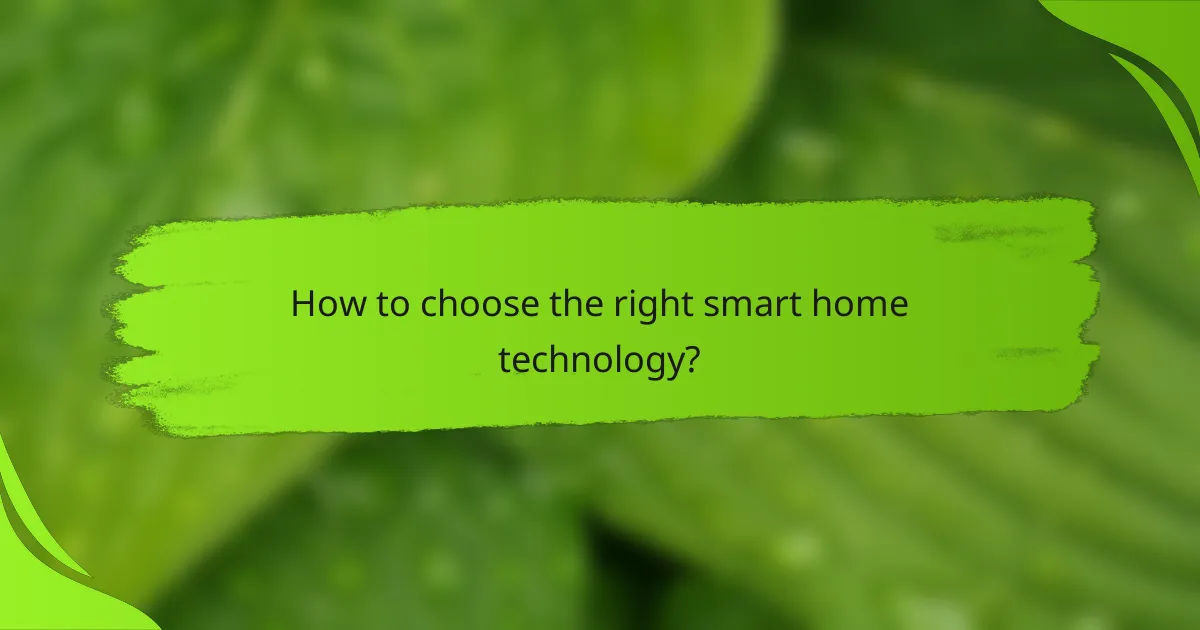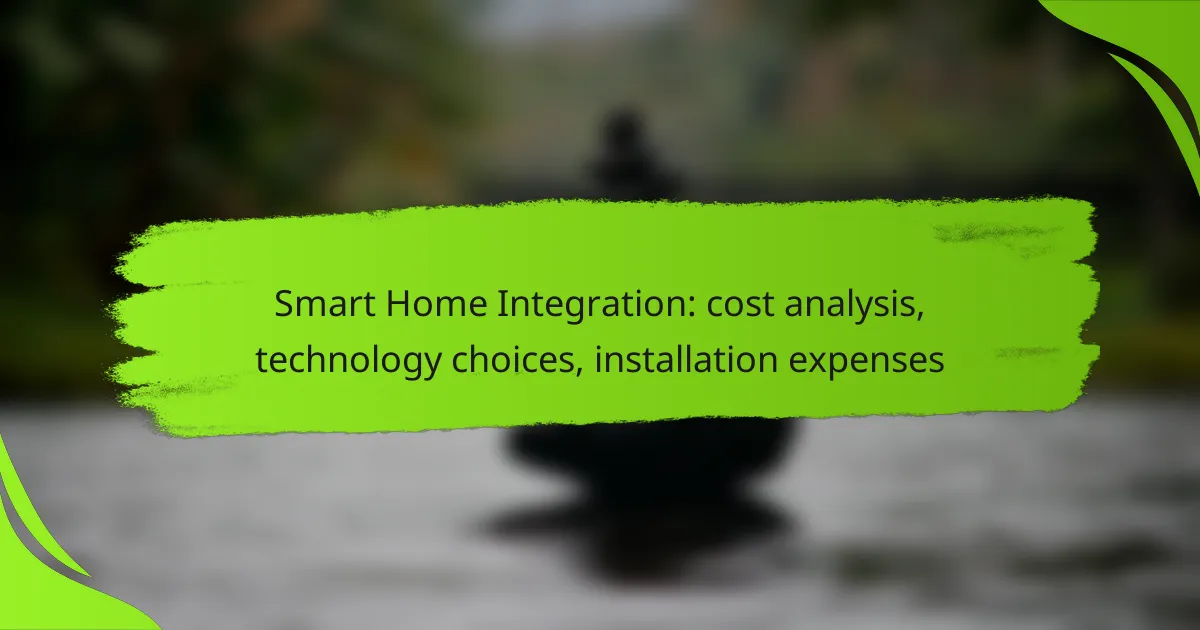Smart home integration presents a range of costs influenced by technology selection, installation complexity, and ongoing service fees. Homeowners can anticipate initial expenses that vary widely, from a few hundred to several thousand dollars, depending on their specific requirements. By evaluating compatibility, ease of use, and scalability, individuals can create a smart home setup that enhances convenience, security, and energy efficiency.

What are the costs of smart home integration in the US?
The costs of smart home integration in the US can vary significantly based on the technology chosen, installation complexity, and ongoing service fees. Homeowners can expect initial expenses ranging from a few hundred to several thousand dollars, depending on their specific needs and preferences.
Average installation costs
Installation costs for smart home systems typically range from $100 to $2,000, depending on the complexity and number of devices being integrated. Basic setups, such as smart lighting or security cameras, may incur lower costs, while comprehensive systems that include smart thermostats, locks, and home automation hubs can be more expensive.
Homeowners should consider whether they will install the devices themselves or hire professionals. DIY installations can save money, but professional services ensure proper setup and integration, which can be crucial for more complex systems.
Monthly subscription fees
Many smart home systems require monthly subscription fees for cloud services, monitoring, or advanced features. These fees can range from $5 to $30 per month, depending on the service provider and the features included. For instance, security systems often charge more for 24/7 monitoring compared to basic device control.
It’s important to factor these ongoing costs into your budget when planning a smart home integration. Some devices may offer free basic functionality without a subscription, while others might require a fee for full access to features.
Long-term savings
Investing in smart home technology can lead to long-term savings, particularly through energy efficiency and enhanced security. Smart thermostats, for example, can reduce heating and cooling costs by optimizing usage based on your habits, potentially saving homeowners 10-20% on energy bills.
Additionally, smart security systems can lower insurance premiums by providing increased safety and monitoring capabilities. Homeowners should evaluate these potential savings against the initial and ongoing costs to determine the overall financial impact of their smart home integration.

What technology choices are available for smart home integration?
Smart home integration offers various technology choices that enhance convenience, security, and energy efficiency. Key options include smart speakers, smart lighting, and smart thermostats, each providing unique functionalities and benefits.
Smart speakers (Amazon Echo, Google Nest)
Smart speakers like Amazon Echo and Google Nest serve as central hubs for controlling various smart home devices through voice commands. They connect to Wi-Fi and can integrate with numerous compatible devices, allowing users to manage their home environment effortlessly.
When choosing a smart speaker, consider compatibility with existing devices and ecosystems. For instance, Amazon Echo works best with Alexa-enabled devices, while Google Nest integrates seamlessly with Google Home products. Prices typically range from around $50 to $200, depending on features and audio quality.
Smart lighting (Philips Hue, LIFX)
Smart lighting systems, such as Philips Hue and LIFX, allow users to control their home lighting remotely or via voice commands. These systems can change colors, adjust brightness, and set schedules, enhancing ambiance and energy efficiency.
Installation usually involves replacing standard bulbs with smart ones, which can be done easily by most homeowners. Expect to spend between $15 and $50 per bulb, depending on the brand and features. Ensure your chosen system is compatible with your smart speaker for optimal integration.
Smart thermostats (Nest, Ecobee)
Smart thermostats like Nest and Ecobee learn user preferences and adjust heating and cooling accordingly, leading to potential energy savings. They can be controlled remotely via smartphone apps, allowing for adjustments even when away from home.
Installation may require professional help, especially for complex systems, but many models offer DIY options. Prices generally range from $100 to $250. Look for features like energy usage reports and compatibility with your HVAC system to maximize benefits.

How to choose the right smart home technology?
Choosing the right smart home technology involves assessing compatibility with your existing systems, ease of use, and scalability for future upgrades. These factors ensure that your smart home setup is functional, user-friendly, and adaptable to your evolving needs.
Compatibility with existing systems
When selecting smart home technology, ensure it integrates seamlessly with your current devices and systems. Check for compatibility with popular platforms like Amazon Alexa, Google Assistant, or Apple HomeKit, as well as specific brands and models you already own.
For example, if you have a smart thermostat, verify that any new smart lighting or security systems can communicate with it. This will help avoid the frustration of managing multiple apps or systems that don’t work together.
User interface and ease of use
The user interface of your smart home technology should be intuitive and easy to navigate. A complicated setup can lead to frustration and decreased usage, so look for systems that offer straightforward controls and clear instructions.
Consider options that provide mobile apps with user-friendly designs, voice control capabilities, or even physical remotes. Testing out the interface before purchasing can help you determine if it meets your usability standards.
Scalability for future upgrades
Scalability is crucial for ensuring your smart home technology can grow with your needs. Choose systems that allow for easy addition of new devices without requiring a complete overhaul of your existing setup.
Look for platforms that support a wide range of devices and have a proven track record of regular updates and new integrations. This way, you can expand your smart home ecosystem over time without facing compatibility issues or obsolescence.

What are the installation expenses for smart home systems?
Installation expenses for smart home systems can vary significantly based on the complexity of the setup and whether you choose professional help or a DIY approach. Generally, costs can range from a few hundred to several thousand dollars, depending on the technology and features you select.
Professional installation costs
Hiring professionals for smart home system installation typically costs between $100 and $200 per hour, with total expenses often reaching $500 to $2,000 depending on the system’s complexity. Factors influencing these costs include the number of devices, the type of technology, and the specific requirements of your home.
For example, a basic installation of smart lighting and a thermostat may be on the lower end, while a comprehensive setup with security cameras, smart locks, and home automation could push costs higher. Always request quotes from multiple installers to ensure competitive pricing.
DIY installation savings
Opting for a DIY installation can save you a significant amount of money, potentially reducing costs by 50% or more. Many smart home devices are designed for easy self-installation, often featuring user-friendly apps and step-by-step guides.
However, consider your technical comfort level before proceeding. While DIY can be cost-effective, it may lead to complications if you’re unfamiliar with electrical systems or network configurations. Start with simpler devices to build your confidence.
Hidden fees and additional expenses
When budgeting for smart home installations, be aware of potential hidden fees. These can include costs for additional equipment, such as hubs or adapters, and subscription fees for services like cloud storage or advanced features.
Moreover, consider ongoing maintenance costs, which may arise from software updates or device replacements. It’s wise to set aside a budget of 10-20% of your initial investment for these unforeseen expenses to avoid surprises later on.

What are the benefits of smart home integration?
Smart home integration offers numerous advantages, including enhanced energy efficiency, improved security, and increased convenience. By connecting various devices and systems, homeowners can optimize their living spaces for better functionality and comfort.
Increased energy efficiency
Smart home integration can significantly reduce energy consumption by automating and optimizing the use of appliances and systems. For instance, smart thermostats can learn your schedule and adjust heating or cooling accordingly, potentially saving 10-20% on energy bills.
Additionally, smart lighting systems can be programmed to turn off when rooms are unoccupied, further conserving energy. Homeowners should consider investing in energy-efficient devices that can be easily integrated into their existing systems for maximum savings.
Enhanced security features
Integrating smart security devices, such as cameras, motion detectors, and smart locks, provides homeowners with real-time monitoring and control over their property. These systems can send alerts to your smartphone if unusual activity is detected, allowing for quick responses.
Moreover, features like remote access and automated lighting can deter potential intruders. It’s essential to choose devices that are compatible with each other and to regularly update their software to maintain security standards.
Improved convenience and comfort
Smart home integration enhances daily living by allowing users to control various devices from a single interface, such as a smartphone or voice assistant. This can include adjusting the thermostat, controlling lights, or managing entertainment systems, all with simple commands.
Additionally, automated routines can be set up to streamline tasks, such as having lights dim and music play when it’s time to relax. Homeowners should explore user-friendly platforms that offer seamless integration of multiple devices to maximize comfort and convenience.
